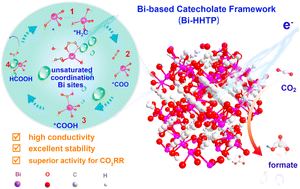A conductive catecholate-based framework coordinated with unsaturated bismuth boosts CO2 electroreduction to formate†
Abstract
Bismuth-based metal–organic frameworks (Bi-MOFs) have received attention in electrochemical CO2-to-formate conversion. However, the low conductivity and saturated coordination of Bi-MOFs usually lead to poor performance, which severely limits their widespread application. Herein, a conductive catecholate-based framework with Bi-enriched sites (HHTP, 2,3,6,7,10,11-hexahydroxytriphenylene) is constructed and the zigzagging corrugated topology of Bi–HHTP is first unraveled via single-crystal X-ray diffraction. Bi–HHTP possesses excellent electrical conductivity (1.65 S m−1) and unsaturated coordination Bi sites are confirmed by electron paramagnetic resonance spectroscopy. Bi–HHTP exhibited an outstanding performance for selective formate production of 95% with a maximum turnover frequency of 576 h−1 in a flow cell, which surpassed most of the previously reported Bi-MOFs. Significantly, the structure of Bi–HHTP could be well maintained after catalysis. In situ attenuated total reflectance Fourier transform infrared spectroscopy (ATR-FTIR) confirms that the key intermediate is *COOH species. Density functional theory (DFT) calculations reveal that the rate-determining step is *COOH species generation, which is consistent with the in situ ATR-FTIR results. DFT calculations confirmed that the unsaturated coordination Bi sites acted as active sites for electrochemical CO2-to-formate conversion. This work provides new insights into the rational design of conductive, stable, and active Bi-MOFs to improve their performance towards electrochemical CO2 reduction.

- This article is part of the themed collections: 2023 Chemical Science HOT Article Collection and 2023 Chemical Science Covers


 Please wait while we load your content...
Please wait while we load your content...